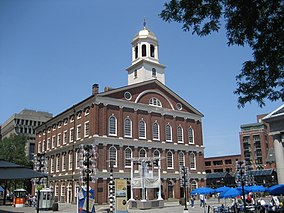Boston National Historical Park
| Boston National Historical Park | |
|---|---|
|
IUCN category V (protected landscape/seascape)
|
|

|
|
| Location | Boston, Massachusetts, USA |
| Nearest city | Boston, MA |
| Coordinates | 42°21′36″N 71°03′23″W / 42.36000°N 71.05639°WCoordinates: 42°21′36″N 71°03′23″W / 42.36000°N 71.05639°W |
| Area | 43 acres (17 ha) |
| Established | October 1, 1974 |
| Visitors | 2,262,841 (in 2015) |
| Governing body | National Park Service |
| Website | Boston National Historical Park |
The Boston National Historical Park is an association of sites that showcase Boston's role in the American Revolution. It was designated a national park on October 1, 1974. Seven of the eight sites are connected by the Freedom Trail, a walking tour of downtown Boston. All eight properties are National Historic Landmarks.
Five of the sites that make up the park are neither owned nor operated by the National Park Service, and operate through cooperative agreements established upon the park's creation. The park service operates visitor centers in Faneuil Hall and at the Charlestown Navy Yard.
The Bunker Hill Monument, located at the top of Breed's Hill in the Charlestown neighborhood of Boston, is a granite obelisk that was constructed in the mid-19th century to commemorate the Battle of Bunker Hill, fought June 17, 1775. The property is owned and administered by the National Park Service. The park service also operates the nearby Bunker Hill Museum.
The Charlestown Navy Yard is located on the southern edge of Charlestown on the banks of the Charles River. Used during the American Revolutionary War as a shipyard, it continued to serve as a base of the United States Navy until 1975, when the Navy turned the property over to the National Park Service. The Yard is home to the USS Constitution (the oldest floating commissioned naval vessel in the world), and the USS Cassin Young, a destroyer from the Second World War that is now operated as a museum ship.
...
Wikipedia

